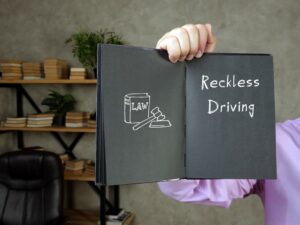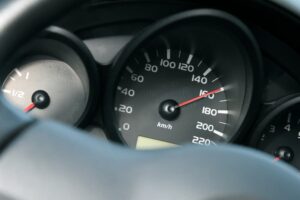What Is Considered Reckless Driving?
What Is Considered Reckless Driving?
Reckless driving can take many forms, from aggressive tailgating to speeding to weaving in and out of busy highway traffic. When people drive carelessly and recklessly regularly, they significantly increase their chances of causing an accident.
If you suffered injuries in a crash that resulted from another driver’s reckless driving, you may be entitled to recover monetary compensation. An experienced car accident lawyer in your area can evaluate the strength of your claim, submit documents to the at-fault driver’s insurance company, and pursue the monetary compensation you deserve through settlement or litigation.
Schedule a Free Initial Consultation
Common Types of Reckless Driving Maneuvers That Lead to Traffic Accidents
Reckless driving encompasses a range of dangerous behaviors on the road, posing a significant risk to drivers, passengers, pedestrians, and other road users. Understanding the most common types of reckless driving is crucial for promoting road safety and preventing potentially life-threatening incidents.
- Excessive Speeding — Driving at speeds significantly higher than posted speed limits or too fast for road conditions is a common form of reckless driving. High-speed collisions can lead to severe injuries and fatalities due to reduced reaction times and increased impact forces.
- Aggressive Tailgating — Tailgating, or following another vehicle too closely, is a reckless behavior that increases the risk of rear-end collisions. Aggressive tailgating can lead to chain-reaction accidents, especially when sudden braking is required.
- Unsafe Overtaking — Reckless drivers may attempt unsafe overtaking maneuvers, such as passing on curves in no-passing zones or without proper visibility. This behavior can lead to head-on collisions or collisions with oncoming traffic.
- Running Red Lights and Stop Signs — Disregarding traffic signals and signs is a reckless behavior that can result in broadside collisions, T-bone accidents, or collisions with pedestrians and cyclists in intersections.
- Distracted Driving — Engaging in activities that divert attention from the road, such as texting, talking on the phone, or using in-car entertainment systems, is a common form of reckless driving. Distracted drivers are less likely to notice potential hazards, increasing the risk of accidents.
- Weaving In and Out of Traffic — Reckless drivers may engage in erratic lane changes, weaving between vehicles without signaling or proper regard for other road users. This behavior can lead to sideswipes, collisions, and overall road instability.
- Ignoring Road Conditions — Failing to adjust driving behavior to match adverse weather conditions, such as heavy rain, snow, or ice, is a form of reckless driving. Poor visibility and slippery road surfaces increase the risk of accidents.
- Reckless Lane Changes — Abrupt and unsafe lane changes, such as cutting off other vehicles, failing to signal, or changing lanes without proper checking, are reckless behaviors that can lead to collisions.
- Drunk Driving — Driving under the influence of alcohol or drugs impairs judgment, coordination, and reaction times. Drunk driving is a highly reckless behavior that significantly increases the likelihood of accidents and severe injuries.
- Street Racing — Engaging in illegal street racing is an extremely reckless behavior. Racing on public roads poses a grave danger to participants and innocent bystanders, often resulting in catastrophic accidents.
Combating reckless driving requires law enforcement efforts, public awareness campaigns, and individual responsibility. Strict enforcement of traffic laws, penalties for reckless driving offenses, and education on the potential consequences of these behaviors contribute to fostering a safer road environment for everyone.
Types of Accidents That Result from Reckless Driving
Reckless driving collisions, fueled by dangerous behaviors on the road, can result in various types of accidents, each with its own set of risks and consequences. Understanding the most common types of reckless driving collisions sheds light on the potential hazards of these behaviors.

- Rear-end Collisions — Reckless behaviors like aggressive tailgating and excessive speeding contribute to rear-end collisions. When a driver follows too closely or fails to maintain a safe stopping distance, they increase the risk of colliding with the vehicle in front during sudden stops or changes in traffic flow.
- Head-on Collisions — Reckless overtaking, speeding, and driving on the wrong road can lead to head-on collisions. These collisions are often severe and result in significant injuries or fatalities due to the combined force of the vehicles traveling in opposite directions.
- T-bone (Side Impact) Collisions — Unsafe overtaking, running red lights, or disregarding stop signs can result in T-bone collisions. These occur when the front of one vehicle collides with the side of another, typically at intersections. Side-impact collisions can cause severe injuries, particularly to occupants on the struck side of the vehicle.
- Sideswipe Accidents — Reckless lane changes, weaving in and out of traffic, or failing to signal can cause sideswipe collisions. These accidents typically occur when two vehicles traveling parallel make contact, often leading to loss of control and subsequent crashes.
- Rollover Accidents — High-speed reckless driving, especially on curves or uneven surfaces, increases the likelihood of rollover accidents. Vehicles may overturn, causing severe injuries to occupants and potentially involving other vehicles in the collision.
- Multiple Vehicle Pileups — Reckless driving behaviors can contribute to multi-vehicle pileups, especially on highways or in congested traffic. Excessive speeding, aggressive maneuvers, and tailgating create an environment conducive to chain-reaction collisions involving numerous vehicles.
- Intersection Collisions — Ignoring traffic signals, running red lights, or failing to yield the right-of-way can result in collisions at intersections. Reckless drivers may enter an intersection without proper clearance, leading to broadside collisions or collisions with other vehicles and pedestrians.
- Pedestrian and Cyclist Accidents — Reckless driving poses a significant threat to pedestrians and cyclists. Ignoring crosswalks, speeding in residential areas, or failing to yield to pedestrians can result in collisions with vulnerable road users, causing severe injuries or fatalities.
- Vehicle-to-barrier Crashes — Failing to navigate curves or turns at high speeds can lead to collisions with barriers such as guardrails, medians, or concrete dividers. These crashes can cause substantial damage to the vehicle and pose risks to the driver and passengers.
- Distracted Driving Collisions — Reckless behaviors associated with distracted driving, texting, or using in-car entertainment systems can lead to various collisions. Distracted drivers may fail to notice changes in traffic conditions, increasing the likelihood of accidents.
Preventing reckless driving collisions requires law enforcement efforts, public education, and individual responsibility. Stricter enforcement of traffic laws, increased penalties for reckless driving offenses, and campaigns promoting safe driving behaviors create a safer road environment for everyone.
What Are the Most Common Injuries in a Reckless Driving Accident?
Reckless driving car crashes often result in severe and diverse injuries due to the high speeds and dangerous behaviors involved. Common injuries in these incidents can have significant physical, emotional, and financial consequences for those involved.
- Trauma Brain Injuries (TBIs) — High-impact collisions associated with reckless driving can lead to traumatic brain injuries. These injuries range from concussions to more severe forms of brain trauma, affecting cognitive function, memory, and overall brain health.
- Spinal Cord Injuries — Reckless driving collisions may cause spinal cord injuries, leading to varying degrees of paralysis or impairment. The sudden impact and force can damage the spinal cord, affecting motor and sensory functions.
- Whiplash and Neck Injuries — Rapid acceleration, deceleration, or sudden stops in reckless driving collisions contribute to whiplash injuries. These involve the rapid back-and-forth motion of the neck, leading to strain on the soft tissues and potential damage to the cervical spine.
- Broken Bones and Fractures — The force of a reckless driving crash can result in broken bones and fractures. Impact on the vehicle’s interior or external objects can cause fractures in the limbs, ribs, or facial bones.
- Internal Organ Injuries — Severe collisions can cause internal organ injuries, including damage to the heart, lungs, liver, or spleen. The blunt force trauma associated with reckless driving accidents poses a significant risk to internal organs.
- Chest and Abdominal Injuries — The impact of a reckless driving collision may lead to chest and abdominal injuries. Bruised or broken ribs, sternum fractures, and injuries to internal organs in the chest and abdominal regions are common.
- Facial Injuries — Collisions can cause facial injuries, including cuts, bruises, and fractures. Deploying airbags, shattered glass, or impact on the steering wheel can lead to injuries affecting the face and head.
- Psychological Trauma — Beyond physical injuries, individuals involved in reckless driving collisions may experience psychological trauma. Post-traumatic stress disorder (PTSD), anxiety, and depression are common psychological consequences of such traumatic events.
- Lacerations and Abrasions — Broken glass, twisted metal, or contact with external objects can result in lacerations and abrasions. These injuries may require stitches or medical attention to prevent infection and facilitate proper healing.
- Burn Injuries — In collisions involving fire or explosions, occupants may sustain burn injuries. These injuries can range from minor burns to more severe, life-threatening burns requiring extensive medical treatment.
Prompt medical attention and comprehensive evaluations are crucial for individuals involved in reckless driving car crashes. Seeking support from healthcare professionals, rehabilitation services, and mental health professionals is essential for addressing the immediate and long-term effects of these traumatic events.
How Do I File a Personal Injury Claim After a Reckless Driving Accident?
Filing a personal injury claim after a reckless driving accident involves a structured process to seek compensation for damages incurred due to another driver’s negligent and dangerous actions. Here are key steps to consider when pursuing a personal injury claim:

- Seek Immediate Medical Attention — The priority after a reckless driving accident is to seek immediate medical attention for any injuries sustained. Seeking immediate medical care ensures your well-being and establishes a vital record of your injuries, which your personal injury claim can demonstrate.
- Document the Scene — If possible, gather information at the accident scene. Take photographs of the vehicles, the surrounding area, and any visible injuries. Collect names and contact information from witnesses. These details can serve as valuable evidence when filing your personal injury claim.
- Contact Law Enforcement — Notify the police about the reckless driving accident and ensure an official accident report is filed. The police report will document details of the accident, statements from involved parties and witnesses, and the officer’s assessment of the situation. Obtain a copy of this report for your records.
- Exchange Information — Exchange information with the other driver involved in the reckless driving accident. Obtain their name, contact information, insurance details, and vehicle registration information. This information will be necessary when filing your personal injury claim.
- Do Not Admit Fault — Avoid making statements interpreted as an admission of guilt or admitting fault. Stick to providing factual information to the police and other parties involved.
- Preserve Evidence — Preserve evidence related to the reckless driving accident. This includes retaining medical records, repair estimates for vehicle damage, photos from the scene, and any communication with insurance companies or the other driver.
- Contact Your Insurance Company — Report the reckless driving accident to your insurance company immediately. Provide them with the necessary information, but be cautious when discussing the accident details. Always consult a personal injury attorney before providing detailed statements to insurance adjusters.
- Consult with a Personal Injury Attorney — Seeking legal representation.
This is crucial when filing a personal injury claim. An experienced personal injury attorney can assess the merits of your case, guide you through the legal process, and advocate on your behalf. They facilitate understanding your rights, assessing potential compensation, and navigating negotiations with insurance companies.
- Determine Damages — Consult with your attorney to identify and quantify the damages you have suffered. This includes medical expenses, property damage, lost income, pain and suffering, and any other losses resulting from the reckless driving accident.
- File the Personal Injury Claim — Your attorney will guide the preparation and filing of the claim. This involves submitting the necessary documentation, evidence, and a clear narrative of the events leading to the reckless driving accident. You can file the claim with the at-fault driver’s insurance company.
- Negotiate or Litigate —After filing the personal injury claim, negotiations with the insurance company may occur. Your attorney will advocate for fair compensation. If parties cannot reach a satisfactory settlement, you might initiate legal proceedings, culminating in a formal lawsuit and potentially a trial in the court system.
Filing a personal injury claim after a reckless driving accident requires careful attention to detail and legal experience. Engaging the services of a qualified personal injury attorney enhances your chances of obtaining fair compensation for the damages you have suffered.
Talk with a Skilled Car Accident Attorney in Your Area Today

Greg Bentley, Car Accident Lawyer
If you sustained injuries in a recent reckless driving accident, time is of the essence. Under the statute of limitations, accident victims have only two years from their accident date to file a personal injury lawsuit for monetary compensation. Once you retain an experienced personal injury lawyer for representation, they can file a timely claim or lawsuit on your behalf and aggressively pursue the financial compensation you deserve for your accident-related losses.


